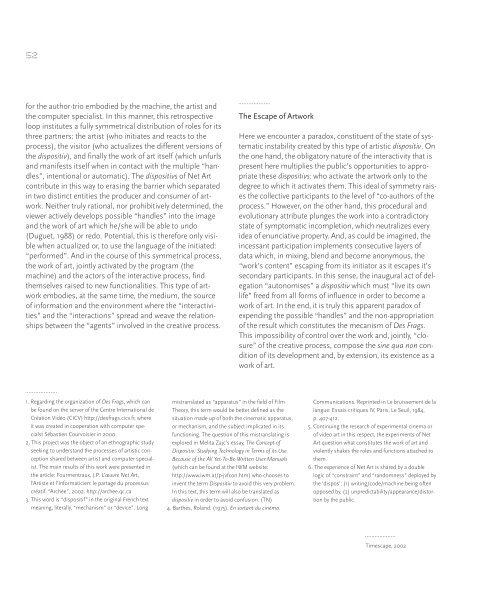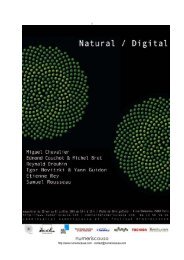Télécharger le pdf de la publication - Reynald Drouhin
Télécharger le pdf de la publication - Reynald Drouhin
Télécharger le pdf de la publication - Reynald Drouhin
Create successful ePaper yourself
Turn your PDF publications into a flip-book with our unique Google optimized e-Paper software.
52<br />
for the author-trio embodied by the machine, the artist and<br />
the computer specialist. In this manner, this retrospective<br />
loop institutes a fully symmetrical distribution of ro<strong>le</strong>s for its<br />
three partners: the artist (who initiates and reacts to the<br />
process), the visitor (who actualizes the different versions of<br />
the dispositiv), and finally the work of art itself (which unfurls<br />
and manifests itself when in contact with the multip<strong>le</strong> “hand<strong>le</strong>s”,<br />
intentional or automatic). The dispositivs of Net Art<br />
contribute in this way to erasing the barrier which separated<br />
in two distinct entities the producer and consumer of artwork.<br />
Neither truly rational, nor prohibitively <strong>de</strong>termined, the<br />
viewer actively <strong>de</strong>velops possib<strong>le</strong> “hand<strong>le</strong>s” into the image<br />
and the work of art which he/she will be ab<strong>le</strong> to undo<br />
(Duguet, 1988) or redo. Potential, this is therefore only visib<strong>le</strong><br />
when actualized or, to use the <strong>la</strong>nguage of the initiated:<br />
“performed”. And in the course of this symmetrical process,<br />
the work of art, jointly activated by the program (the<br />
machine) and the actors of the interactive process, find<br />
themselves raised to new functionalities. This type of artwork<br />
embodies, at the same time, the medium, the source<br />
of information and the environment where the “interactivities”<br />
and the “interactions” spread and weave the re<strong>la</strong>tionships<br />
between the “agents” involved in the creative process.<br />
...................<br />
1. Regarding the organization of Des Frags, which can<br />
be found on the server of the Centre International <strong>de</strong><br />
Création Vidéo (CICV) http://<strong>de</strong>sfrags.cicv.fr, where<br />
it was created in cooperation with computer specialst<br />
Sébastien Courvoisier in 2000.<br />
2. This project was the object of an ethnographic study<br />
seeking to un<strong>de</strong>rstand the processes of artistic conception<br />
shared between artist and computer specialist.<br />
The main results of this work were presented in<br />
the artic<strong>le</strong>: Fourmentraux, J.P. L’œuvre Net Art,<br />
l’Artiste et l’Informaticien: <strong>le</strong> partage du processus<br />
créatif. “Archée”, 2002. http://archee.qc.ca<br />
3. This word is “dispositif” in the original French text<br />
meaning, literally, “mechanism” or “<strong>de</strong>vice”. Long<br />
...................<br />
The Escape of Artwork<br />
mistrans<strong>la</strong>ted as “apparatus” in the field of Film<br />
Theory, this term would be better <strong>de</strong>fined as the<br />
situation ma<strong>de</strong> up of both the cinematic apparatus,<br />
or mechanism, and the subject implicated in its<br />
functioning. The question of this mistrans<strong>la</strong>ting is<br />
explored in Melita Zajc’s essay, The Concept of<br />
Dispositiv: Studying Technology in Terms of its Use.<br />
Because of the All Yet-To-Be-Written User Manuals<br />
(which can be found at the IWM website:<br />
http://www.iwm.at/p-jvfcon.htm) who chooses to<br />
invent the term Dispositiv to avoid this very prob<strong>le</strong>m.<br />
In this text, this term will also be trans<strong>la</strong>ted as<br />
dispositiv in or<strong>de</strong>r to avoid confusion. (TN)<br />
4. Barthes, Ro<strong>la</strong>nd. (1975). En sortant du cinéma.<br />
Here we encounter a paradox, constituent of the state of systematic<br />
instability created by this type of artistic dispositiv. On<br />
the one hand, the obligatory nature of the interactivity that is<br />
present here multiplies the public’s opportunities to appropriate<br />
these dispositivs: who activate the artwork only to the<br />
<strong>de</strong>gree to which it activates them. This i<strong>de</strong>al of symmetry raises<br />
the col<strong>le</strong>ctive participants to the <strong>le</strong>vel of “co-authors of the<br />
process.” However, on the other hand, this procedural and<br />
evolutionary attribute plunges the work into a contradictory<br />
state of symptomatic incomp<strong>le</strong>tion, which neutralizes every<br />
i<strong>de</strong>a of enunciative property. And, as could be imagined, the<br />
incessant participation imp<strong>le</strong>ments consecutive <strong>la</strong>yers of<br />
data which, in mixing, b<strong>le</strong>nd and become anonymous, the<br />
“work’s content” escaping from its initiator as it escapes it’s<br />
secondary participants. In this sense, the inaugural act of <strong>de</strong><strong>le</strong>gation<br />
“autonomises” a dispositiv which must “live its own<br />
life” freed from all forms of influence in or<strong>de</strong>r to become a<br />
work of art. In the end, it is truly this apparent paradox of<br />
expending the possib<strong>le</strong> “hand<strong>le</strong>s” and the non-appropriation<br />
of the result which constitutes the mecanism of Des Frags.<br />
This impossibility of control over the work and, jointly, “closure”<br />
of the creative process, compose the sine qua non condition<br />
of its <strong>de</strong>velopment and, by extension, its existence as a<br />
work of art.<br />
Communications. Reprinted in Le bruissement <strong>de</strong> <strong>la</strong><br />
<strong>la</strong>ngue: Essais critiques IV, Paris, Le Seuil, 1984,<br />
p. 407-412.<br />
5. Continuing the research of experimental cinema or<br />
of vi<strong>de</strong>o art in this respect, the experiments of Net<br />
Art question what constitutes the work of art and<br />
vio<strong>le</strong>ntly shakes the ro<strong>le</strong>s and functions attached to<br />
them.<br />
6. The experience of Net Art is shared by a doub<strong>le</strong><br />
logic of “constraint” and “randomness” <strong>de</strong>ployed by<br />
the ‘dispos’: (1) writing/co<strong>de</strong>/machine being often<br />
opposed by, (2) unpredictability/appearance/distortion<br />
by the public.<br />
...................<br />
Timescape, 2002






